7 Best Grass Types for Florida
BY MELANIE JOSEPH | MAY 8TH, 2023 | FLORIDA, LAWN CAREThe Sunshine State is well-known for its beautiful beaches, warm weather, and unique wildlife. But when it comes to landscaping, choosing the right type of grass is key to maintaining a lush and healthy lawn in Florida’s subtropical climate.
You should look for grass types with good heat tolerance and resistance to pests and diseases, as they are necessary to survive this region’s hot and humid summers and mild winters. Fortunately, several grass types thrive in this tropical state. Let’s explore the 7 best grass types for Florida, so you can keep your lawn looking green and healthy year-round.
- Warm-Season vs. Cool-Season Grasses
- 7 Best Warm-Season Grasses for Florida
- How to Choose the Best Grass for North Florida
- How to Choose the Best Grass for Central Florida
- How to Choose the Best Grass for South Florida
- FAQ About Florida Grass Types
Warm-Season vs. Cool-Season Grasses
Understanding each grass variety’s distinct growth patterns and requirements is essential in determining the best fit for your lawn. Categorizing grass types into two general groups based on their temperature preferences simplifies the selection process and makes it easier to make an informed decision.
Warm-season grasses: Growing actively when the temperatures are between 80 to 95 degrees Fahrenheit, these grasses thrive during summer. Some examples of warm-season grasses that can tolerate drought and high temperatures include bermudagrass and Zoysiagrass. For the best results, you should plant these grasses in late spring or early summer.
Cool-season grasses: These grasses, such as Kentucky bluegrass and tall fescue, thrive in colder temperatures that range from 60 to 75 degrees Fahrenheit. As such, they are best suited for spring and fall when temperatures are milder. But since they prefer winter weather, these grass types may struggle during the hot summer months.
Selecting the ideal grass type based on your lawn’s unique qualities and the prevailing weather conditions is crucial in ensuring a healthy and attractive lawn year-round. In the subtropical climate of Florida, where summers are hot and humid, warm-season grasses are the best choice.
7 Best Warm-Season Grasses for Florida
Choosing the perfect grass variety is the first step in turning your backyard into a verdant paradise. In Florida, where warm-season grasses thrive, you have plenty of options to choose from, including:
1. Bahiagrass
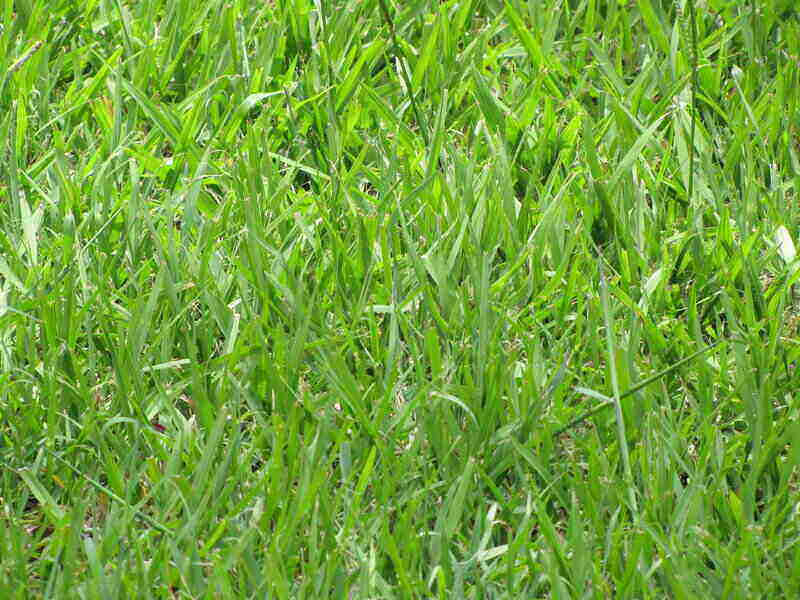
Photo Credit: Forest and Kim Starr / Flickr / CC BY 2.0
A great option for lawns in Central and South Florida, bahiagrass thrives in the warmer temperatures of these regions. It also can be planted in North Florida, but it may not be as cold-tolerant as some other grass varieties, and homeowners in this region may need to take extra precautions during colder months.
This drought-tolerant grass requires little water, making it an ideal choice for areas with limited rainfall. Its ability to establish deep roots helps it tolerate drought conditions and stay green during periods of low rainfall. Note, though, that extended periods of dry spells may cause it to become dormant.
Classification: Warm-season grass
Spreads by: Rhizomes
Shade tolerance: Low – it needs full sun to grow well
Drought resistance: High
Foot traffic tolerance: Low
Maintenance needs: Moderate to high – mow every week or two to control its seed heads (you may have to mow more often during summer)
Mowing height: 3-4 inches
Potential for disease: Low resistance – can be susceptible to ergot diseases and dollar spot (especially the Pensacola cultivar)
Potential for pests: Moderate resistance – mostly prone to mole crickets
Soil pH: 5.5-6.5
Soil type: Prefers sandy loam but grows in most types of soil
Other notes: Growing grass from seeds typically takes more time and effort to establish compared to using sod. While other methods, such as sprigging and plugging, may be viable alternatives, they may potentially increase the risk of weed infestation.
2. Bermudagrass
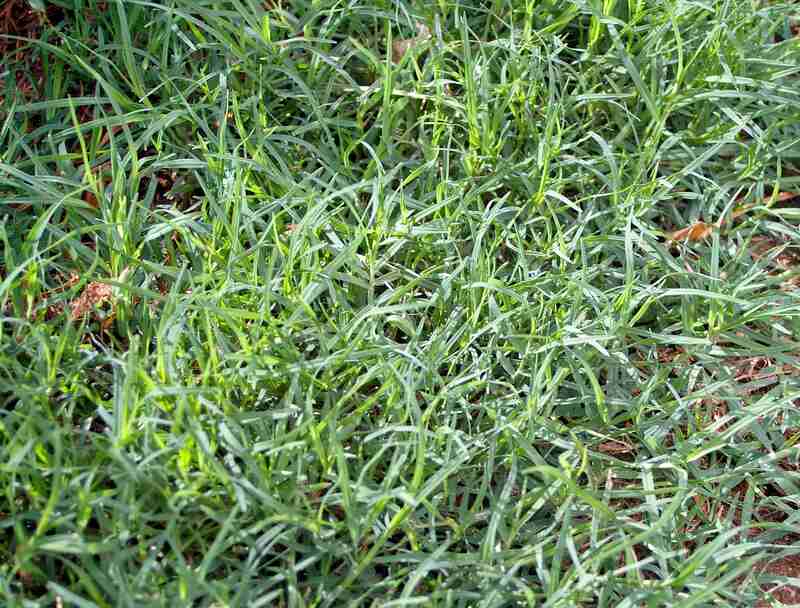
Photo Credit: Bidgee / Wikimedia Commons / CC BY-SA 3.0
Known for its high wear tolerance, bermudagrass is a popular choice for sports fields, golf courses, and parks throughout the state. It is best suited for South and Central Florida, as well as the coastal areas of Northern Florida, where the warm and humid weather conditions are ideal for its growth.
Since this warm-season grass is drought-tolerant, it’s perfect for homeowners that experience frequent water restrictions. And with its rapid growth rate, bermudagrass can help you achieve a quick establishment of your lawn. You can plant it using sod, seed, or sprigs, and it will tolerate a wide range of soil types.
Classification: Warm-season grass
Spreads by: Stolons and rhizomes
Shade tolerance: Low – some cultivars need more direct sun exposure than others
Drought tolerance: High – extended periods of drought may cause it to turn brown and enter dormancy
Foot traffic tolerance: High
Maintenance needs: Moderate to high – it requires mowing, watering, and fertilization more often
Recommended mowing height: 1-2 inches – during periods of extreme heat or drought, you’ll have to raise the mowing height to retain moisture
Potential for disease: Moderate resistance – may be prone to dollar spot, brown patch, spring dead spot, and leaf spot
Potential for pests: Low resistance – can be susceptible to mole crickets, armyworms, hunting billbugs, and white grubs
Soil pH: 6-6.5
Soil type: Prefers loam soil but can grow in most types of soil
Other notes: For optimal results, reseed bermudagrass during the late spring or early summer, when temperatures range from 70 to 90 degrees Fahrenheit. Consistent watering is key to promoting germination, which usually takes 10 to 14 days. Keep the newly seeded area moist but not overly saturated to prevent the seeds from washing away or developing mold.
3. Carpetgrass
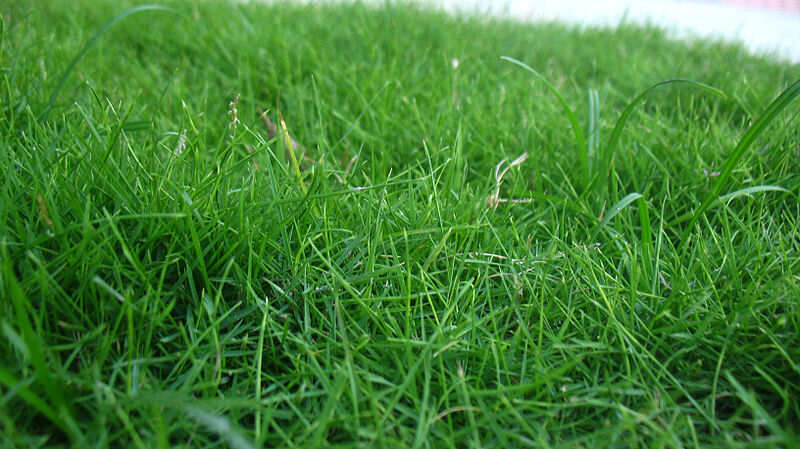
Photo Credit: Sugeesh / Wikimedia Commons / CC BY-SA 3.0
Also called Louisianagrass, this warm-season turfgrass is well-suited to the humid conditions of the Sunshine State. Native to the Gulf Coast region, carpetgrass is best suited for use in the central and southern parts of Florida, where temperatures are warmer and rainfall is abundant. It’s not the best choice for North Florida lawns, as temperatures can drop below its preferred range during winter.
With its impressive tolerance to waterlogging, carpetgrass is an ideal option for Florida lawns that experience high rainfall and flooding. But since it requires consistent moisture, you must water it regularly, especially during drought.
Even with its shallow root system, carpetgrass is still more drought-tolerant than other grass types. It’s typically used in areas that receive light to moderate foot traffic, such as residential lawns and golf courses. This shade-tolerant grass can grow in areas with partial shade, making it ideal for areas with trees or other obstructions that block sunlight.
Classification: Warm-season grass
Spreads by: Stolons
Shade tolerance: Moderate – although it’s not as shade-tolerant as St. Augustinegrass
Drought tolerance: Moderate – its shallow roots will hinder its survival during extreme droughts
Foot traffic tolerance: Low to moderate
Maintenance needs: Moderate to high – you’ll need to mow its tall seed heads every week
Recommended mowing height: 1-2 inches
Potential for disease: Low resistance – can be prone to large patch
Potential for pests: Low resistance – mostly susceptible to white grubs and nematodes
Soil pH: 5-6
Soil type: Acidic, moist (but not muddy), infertile, sandy soil
Other notes: For the seeds to germinate, reseed this warm-season grass in late spring to early summer. Before spreading the seeds, loosen the soil in the area to at least six inches deep.
4. Centipedegrass
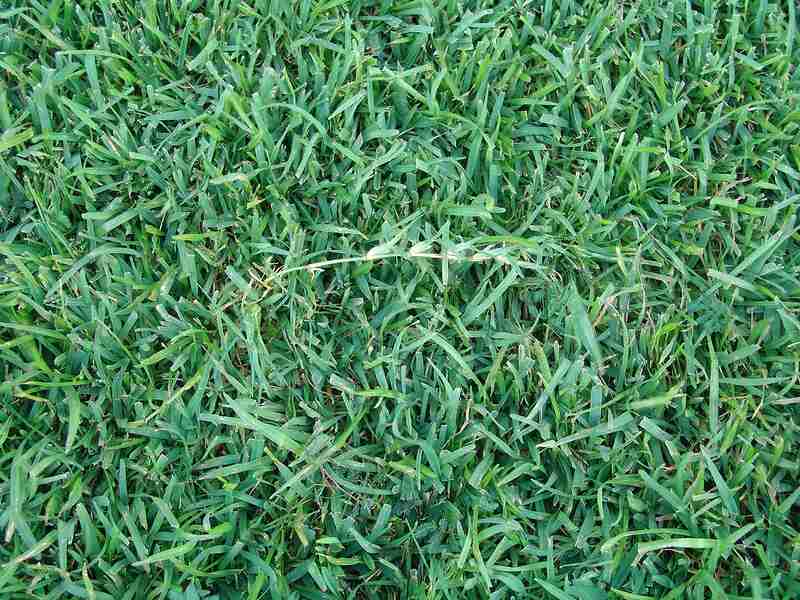
Photo Credit: James Becwar / Wikimedia Commons / CC0 1.0
Another warm-season grass that thrives in Florida’s climate, centipedegrass is best suited for lawns in South and Central Florida, where the temperatures remain consistently warm throughout the year. It has a natural green color and a fine, soft texture, giving it a lush appearance.
This slow-growing grass requires minimal mowing, watering, and fertilization. And since it’s tolerant of drought and shade, centipedegrass can withstand Florida’s unpredictable weather. While it may not be as tolerant of traffic as other grass types, it’s still a popular choice for residential lawns and ornamental gardens due to its low-maintenance requirements.
Classification: Warm-season grass
Spreads by: Stolons
Shade tolerance: Moderate – prefers full sun but can still grow in partial shade with just six hours of sun exposure
Drought tolerance: Low to moderate – prolonged periods of dry spells can cause it to go dormant
Foot traffic tolerance: Low
Maintenance needs: Low
Recommended mowing height: 1.5-2 inches – for lawns in shaded areas, increase the mower height by half an inch
Potential for disease: Moderate resistance – mostly susceptible to iron chlorosis and centipedegrass decline
Potential for pests: Low resistance – can be prone to spittlebugs, sod webworms, mole crickets, ground pearl insects, and nematodes
Soil pH: 5-6
Soil type: Well-drained, fertile, acidic soil
Other notes: With its relatively low maintenance requirements and slow growth rate, this grass variety doesn’t need reseeding as often as the other grass types. But you’ll know it’s time to reseed when you see bare and thinning spots on your lawn.
5. Seashore Paspalum
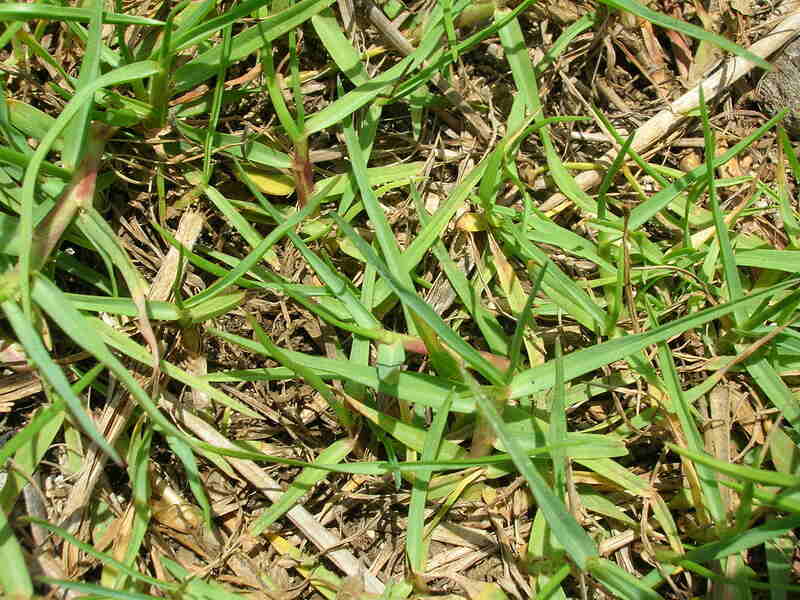
Photo Credit: Forest & Kim Starr / Wikimedia Commons / CC BY 3.0
This warm-season grass is known for its salt tolerance and ability to thrive in coastal areas. Commonly used in South Florida, seashore paspalum also can be grown in other parts of the state. It’s ideal for areas that experience frequent saltwater intrusions, such as coastal golf courses and beachfront properties.
Its unique blue-green color and fine texture make it a popular choice for high-end landscapes. In fact, it can maintain its color and texture even in harsh conditions. It grows best in temperatures between 75 to 95 degrees Fahrenheit and requires regular watering to keep it looking its best. While seashore paspalum can tolerate saltwater, it still requires well-draining soil and proper irrigation.
Classification: Warm-season grass
Spreads by: Stolons
Shade tolerance: Very low
Drought tolerance: Very low
Foot traffic tolerance: High
Maintenance needs: High – needs frequent mowing, watering, and fertilization
Recommended mowing height: 1-2 inches
Potential for disease: High resistance – but it can be susceptible to pythium blight, take-all root rot, and Helminthosporium disease
Potential for pests: High resistance – but may be affected by mole crickets, sod webworms, and fall armyworms
Soil pH: 6-8
Soil type: Prefers well-drained soil but can still thrive in most types of soil
Other notes: This delicate grass type doesn’t tolerate cold weather very well. Applying too much fertilizer can cause thatch buildup, which can prevent it from getting enough water and nutrients. Also, avoid using herbicides that are not specifically labeled for seashore paspalum.
6. St. Augustinegrass
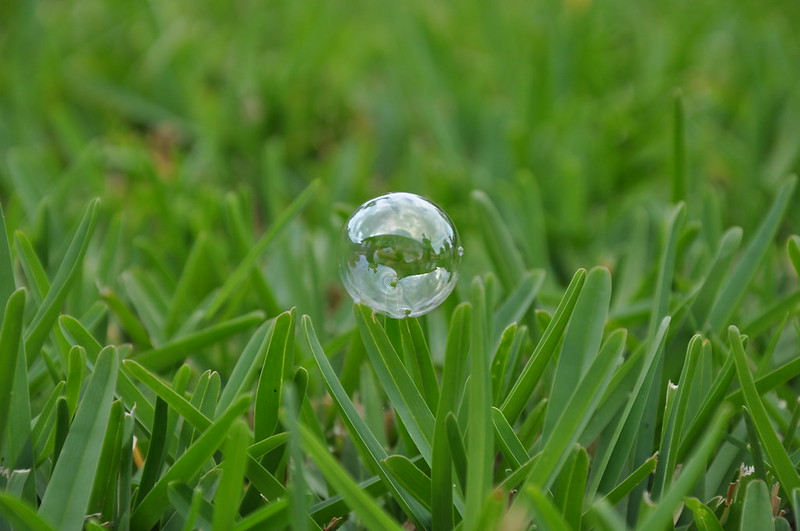
Photo Credit: Jay Morgan / Flickr / CC BY-ND 2.0
Another popular warm-season grass, St. Augustinegrass thrives in the subtropical climate of Florida. Due to its tolerance to salt and high humidity levels, this grass is well-suited for the coastal areas of Central and South Florida. It also performs well in the environmental conditions of North Florida.
With a medium to dark green color and a coarse texture, St. Augustinegrass has a dense growth pattern that can help prevent weed growth. Its shade tolerance is another desirable trait, making it ideal for areas with partial shade.
In terms of care, this grass type requires regular watering and fertilization. It’s also prone to thatch buildup, which can be managed through consistent mowing and aeration. Note that St. Augustinegrass is not tolerant of cold weather and can be damaged by frost.
Classification: Warm-season grass
Spreads by: Stolons
Shade tolerance: Moderate – some cultivars can tolerate shade more than others
Drought tolerance: Moderate
Foot traffic tolerance: Moderate
Maintenance needs: Moderate to high – it needs to be mowed often and requires moderate watering and fertilization
Recommended mowing height: 2.5-4 inches (mow tall in shade, 3-4 inches for standard cultivars, and 2.5-3 inches for dwarf cultivars)
Potential for disease: Low to moderate resistance – common diseases include gray leaf spot, take-all root rot, and large patch
Potential for pests: Low resistance – can be prone to grubs, grass loopers, mole crickets, armyworms, webworms, chinch bugs, and cutworms
Soil pH: 6-7.5
Soil type: Prefers fertile, moist (not muddy) soil but can still grow in most types of soil
Other notes: Not being able to produce viable seeds, St. Augustinegrass usually reproduces through other methods. This grass type is commonly propagated by transplanting sods, sprigs, or plugs to establish a new lawn or fill in bare spots.
7. Zoysiagrass
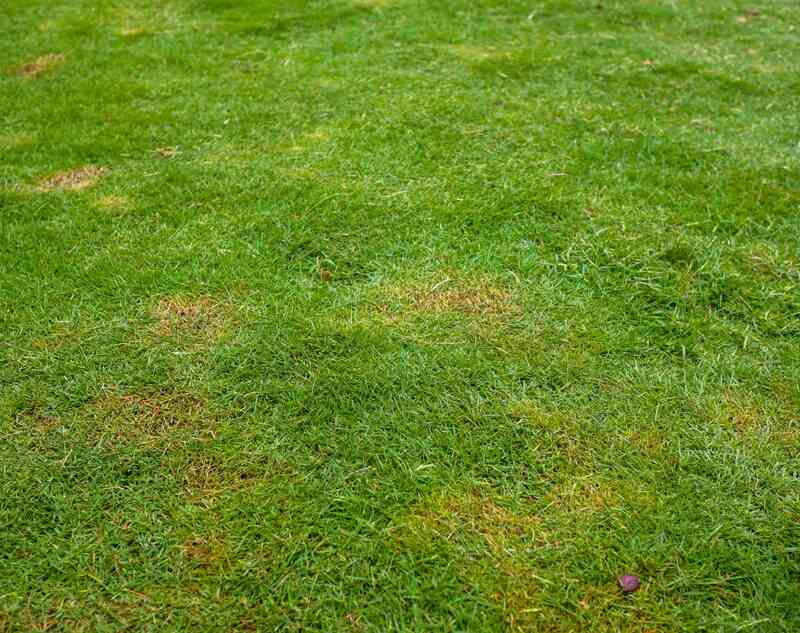
Photo Credit: menikwidyowatis’s Images / Canva Pro / License
Known for its fine blades, dense growth pattern, and beautiful emerald-green color, Zoysiagrass is perfect for lawns, parks, and golf courses. While it can be found in all regions of Florida, it is most commonly used in South and Central Florida due to its tolerance to the hotter and drier conditions found in these areas.
This grass variety’s ability to withstand drought and salty conditions makes it an excellent option for coastal areas, where saltwater intrusion can damage other types of grass. Plus, its strong root system allows it to absorb water and nutrients efficiently, helping it survive periods of low rainfall.
While Zoysiagrass requires less fertilizer and water than other grass types, its slow growth rate can make it difficult to establish a new lawn. It’s best to plant this grass in the spring or early summer to promote growth. And with its moderate resistance to pests and diseases, you’ll have a lesser need for chemical treatments.
Classification: Warm-season grass
Spreads by: Rhizomes and stolons
Shade tolerance: Low to moderate – it requires more direct sun exposure
Drought tolerance: High – but you’ll have to give it supplemental watering during extended periods of drought
Foot traffic tolerance: High
Maintenance needs: Low to moderate
Recommended mowing height: 1-2.5 inches
Potential for disease: Moderate resistance – can be susceptible to spring dead spot, fairy wings, rust, curvularia, dollar spot, root decline, brown patch, leaf spot, and powdery mildew
Potential for pests: Moderate resistance – common pests include chinch bugs, sod webworms, hunting billbugs, armyworms, mole crickets, grubs, and nematodes
Soil pH: 6-6.5
Soil type: Prefers well-drained, loamy soil but can still grow in most soil types
Other notes: Despite its deep root system and ability to tolerate compacted soil, Zoysiagrass may not thrive as much in these conditions as it would in well-aerated soil.
How to Choose the Best Grass for North Florida
With cooler winters and fewer hurricanes, North Florida has a more temperate climate than the rest of Florida. Bordered by Alabama and Georgia, the northernmost region of Florida is known for its natural beauty, including the Gulf Coast beaches in the Florida Panhandle, the Apalachicola National Forest, and the St. Marks National Wildlife Refuge.
Being surrounded by beautiful scenery, you’ll want to make your lawn look just as lovely. And to choose the best grass that will thrive in the unique climate and soil of your region, you need to consider numerous factors, including:
- USDA hardiness zone: 8-9
- Average high temperatures: Mid-60s to mid-80s Fahrenheit
- Soil type: More acidic soil with higher sand content, but some areas have more clay or loam
- Rainfall: Ranges from 50 to 65 inches
Grasses with good cold tolerance are necessary to survive occasional winter freezes, but you’ll also want them to withstand the heat and humidity of the summer months. Some of the best grass types for North Florida include:
- Bermudagrass
- St. Augustinegrass
- Zoysiagrass
The best time to plant grass in this region is during the warm and wet season, typically between April and June. This allows the grass to establish roots and grow before the cooler and drier winter season arrives.
How to Choose the Best Grass for Central Florida
Central Florida is popular for its theme parks, including Universal Orlando and Walt Disney World Resort, as well as its numerous lakes and natural springs. This region, where major cities like Orlando, Tampa, and Lakeland are located, has a humid subtropical climate with mild winters and hot summers.
Choosing the best grass for your Central Florida lawn shouldn’t be difficult as long as you know which grass types thrive in this region. The following factors can help you choose the best turfgrass for your yard:
- USDA hardiness zone: 9-10
- Average high temperatures: Mid-70s to mid-90s Fahrenheit
- Soil type: More alkaline soil with higher clay content, but some areas have sandy soil
- Rainfall: Ranges from 40 to 60 inches
You should look for grass types with good heat tolerance and resistance to pests and diseases, as they are necessary to survive this region’s hot and humid conditions. The following grasses can withstand the heat and humidity of the summer months and survive mild winters:
- Bahiagrass
- St. Augustinegrass
- Zoysiagrass
While these grass types can tolerate the wet and dry conditions of Central Florida, it’s best to plant them between May and September to give them enough time to grow and establish roots before the cold sets in.
How to Choose the Best Grass for South Florida
The most heavily populated and culturally diverse region in the state, South Florida encompasses major cities such as Fort Lauderdale, Miami, and West Palm Beach. It’s also home to the Everglades, a vast subtropical wetland ecosystem, and the Florida Keys off the southern coast of Florida. The climate here is hot and humid year-round, with occasional hurricanes during summer and fall.
To choose the best grass for your South Florida lawn, you need to consider the environmental conditions of this tropical region, including:
- USDA hardiness zone: 10-11
- Average high temperatures: Mid-80s to mid-90s Fahrenheit
- Soil type: More alkaline soil with higher clay content, but some areas have sandy and limestone-based soil
- Rainfall: Ranges from 40 to 60 inches
The following drought-tolerant grasses can thrive in the heat and humidity of South Florida summers:
- Bahiagrass
- Bermudagrass
- St. Augustinegrass
- Zoysiagrass
Remember to plant grasses between May and September when the weather is warm. Additionally, proper lawn care practices like regular fertilization, mowing, and irrigation can help keep your South Florida lawn healthy and beautiful.
FAQ About Florida Grass Types
If your Florida property is prone to flooding, choosing the right grass type can make a significant difference in maintaining a beautiful lawn. St. Augustinegrass and Zoysiagrass may not be the best options since they are not tolerant of standing water.
Instead, consider a grass variety that can tolerate and survive standing water for a short period. One option is carpetgrass, which has a deep root system that makes it resilient even in wet soils. It can endure even the most challenging water conditions, making it perfect for Florida lawns that face seasonal hurricanes and flooding. Centipedegrass is also a suitable option for its tolerance to flooding and adaptability to various soil types.
The amount of water your turfgrass needs depends on various factors, such as the grass type, soil type, weather conditions, and time of year. As a general rule, most Florida lawns require around 1 inch of water per week. During the hot summer months, your lawn may need more frequent watering, while during the cooler months, it may require less.
Water your lawn for longer periods but less frequently. Watering for short periods every day can lead to shallow root growth, and the grass will not be as resilient during dry spells.
Watering at the right time can help conserve water, reduce the risk of fungal diseases, and ensure your grass receives the water it needs to stay healthy.
The best time to water your lawn in Florida is early in the morning, preferably before 10 a.m. This time is ideal because the temperature is cooler, the wind is usually calmer, and the grass has plenty of time to dry before the hotter part of the day. Watering later in the day can lead to excessive water loss due to evaporation, which means your grass won’t be receiving the full benefits of the water.
You should avoid watering your lawn in the afternoon or evening, as this can increase the risk of fungal diseases. Watering during these times can also lead to prolonged periods of wet grass, which can attract pests and cause damage to your lawn.
By integrating native plants into your garden, you can take a step toward conserving natural resources while also creating an eye-catching landscape. Utilizing these plants eliminates the need for excess watering, fertilization, and pest control measures since they have already adapted to Florida’s climate and soil conditions and require little to no maintenance.
Some of the best native plants for Florida include the American beautyberry, coontie, and goldenrod. These plants not only add beauty to your garden, but they also serve as a natural habitat for local wildlife, such as butterflies and birds. Plus, they can help promote biodiversity in the area by attracting a range of beneficial insects and pollinators.
Choose the Right Grass for Your Florida Landscape
Florida’s unique climate and environmental conditions make it essential to select the right grass type for a healthy and vibrant lawn year-round. From bahiagrass to Zoysiagrass, these seven grass types offer unique features and benefits, making them the best options for Florida homeowners.
With their adaptability to Florida’s warm temperatures and humidity, these grass types can thrive even in challenging conditions, such as drought, flooding, and soil compaction, while contributing to the beauty and biodiversity of the Sunshine State’s unique ecosystem.
Whether you need help in Jacksonville, St. Augustine, Tampa, Orlando, Miami, Pensacola, or another city in the Sunshine State, our lawn care professionals can help you achieve a lush and resilient lawn.
Main Image Credit: Boca Grande, Florida / Trish Hartmann / Flickr / CC BY 2.0